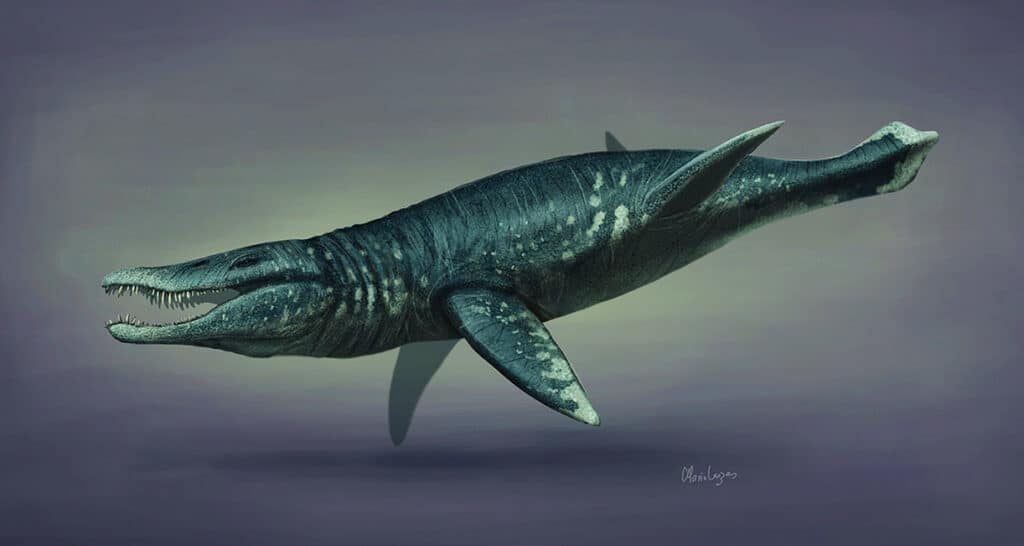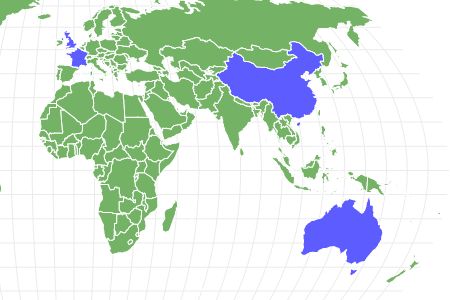Pliosaurs were the short-necked version of plesiosaurs.
Advertisement
Pliosaur Scientific Classification
Read our Complete Guide to Classification of Animals.
Pliosaur Conservation Status
Pliosaur Facts
- Prey
- Fish, dinosaurs, ichthyosaurs, and marine reptiles
- Fun Fact
- Pliosaurs were the short-necked version of plesiosaurs.
- Biggest Threat
- Bigger plesiosaurs
- Most Distinctive Feature
- They had massive and long heads
- Distinctive Feature
- Pliosaurs had four flippers which they used for swimming
- Habitat
- Open oceans, estuarine waters, and freshwater habitats
- Predators
- Bigger plesiosaurs
- Diet
- Carnivore
- Special Features
- Four massive flippers
Pliosaur Physical Characteristics
- Weight
- Up to 100,000 lbs (45 tonnes)
- Length
- 16-85 ft
- Venomous
- No
- Aggression
- Medium
View all of the Pliosaur images!
The pliosaurs were a group of aquatic reptiles that lived in the Mesozoic era (251-66 million years ago). The Mesozoic era includes the Triassic, Jurassic, and Cretaceous periods. They were the major fossil highlights of the Jurassic and Cretaceous periods. The pliosaurs are related to the plesiosaurs, another well-known group of marine reptiles. The length of their neck and general body shape was the main difference between the pliosaurs and their closely related cousins, both members of the order Plesiosauria.
Description and Size
The name Pliosaur (also called Pliosaurus) is from two Greek words, “pleion” and “sauros,” which mean “more” and “saurian.” The name has an interesting origin, further referencing their relationship with the other plesiosaur reptiles. Plesiosaurus was discovered before pliosaurs; when pliosaurs were later found, scientists noticed the similarities between these animals (pliosaurs and plesiosaurs) and considered them members of the same family. This led to the name “more saurian.” The scientists that assigned the name to this group believed they were the link between the Plesiosauroids and Crocodilians that came after them.
Pliosaurs and plesiosaurs are often mistaken for each other mainly because of the similarities in their name and their appearance. Both animals also lived around the same time. However, while plesiosaurs had long necks, pliosaurs had short necks. Also, even though both animals had four flippers, the fore flippers of the pliosaurs were smaller than the hind flippers. The opposite was the case with the plesiosaurs.

Pliosaurs lived around 66 million years ago.
©Mario Lanzas, CC BY-SA 4.0, via Wikimedia Commons – License
Pliosaurs varied considerably in size from one individual to the other. The largest known species in this group were the Kronosaurus and Pliosaurus macromerus. The Kronosaurus grew to lengths of up to 40 ft (12 m), with the skull alone taking up to 12.1 ft of their total length. A newly discovered but unnamed species (nicknamed Predator X) grew to about 50 ft and might have weighed up to 45 tonnes (almost 100,000 pounds).
Their elongated heads contained long, strong jaws with sharp conical teeth. They had powerful jaws which could produce a bite force of up to 33,000 pounds. Although they lived underwater, this marine reptile did not have gills. Instead, they had lungs for breathing and had to surface occasionally for air.
Diet — What Did Pliosaurs Eat?
Pliosaurs were carnivorous reptiles. They were apex predators and could have preyed on virtually any animal in their habitat, small enough for them to take on. They had long and powerful jaws with many sharp, conical teeth. Since they lived in the water, their main prey included sharks, fishes, dinosaurs, ichthyosaurs, and plesiosaurs.
Habitat — When and Where Did Pliosaurs Live?
Pliosaurs lived from the early Jurassic Period of the Mesozoic Era till the early or Mid-Cretaceous period, roughly 66 million years ago. This means they were around for up to 120 million years, dominating the aquatic habitats of the Mesozoic era.
Pliosaurs had a wide range of habitats as their fossils have been found near open oceans, estuarine waters, and even freshwater habitats. They were also found across different locations, including Africa, Australia, Europe, China, South America, North America, England, and France. This suggests they had a widespread distribution all across the globe.
Threats and Predators
Pliosaurs were among the largest predators of their time, and only a few larger predators could take them down. They were the dominant marine reptiles until the mosasaurs came along. These new predators were more vicious and were also more agile. While they probably didn’t attack the pliosaurs, they became their major competitors, eventually displacing them.
Discover and Fossils — Where Pliosaurs were Found
Pliosaurs were first discovered in the 19th century by Richard Owen, who was also the scientist that named them. Plesiosaur fossils had been found earlier, so the proper classification for the newly discovered Pliosaurs baffled scientists for a while. Fossils of these reptiles have been found on almost all continents with fairly complete parts. In 2006, one of the largest pliosaur fossils was discovered on the Arctic island of Svalbard in Norway. This is the largest fossil of this reptile found to date.
Extinction — When Did Pliosaurs Die Out?
Pliosaurs gradually became extinct in the Early Cretaceous period, about 66 million years ago. Their extinction was partially due to their competition with the mosasaurs, which were more agile and better adapted. Some experts think the pliosaurs disappeared because the Mosasaurs outcompeted them. This suggests they were not around when the Cretaceous-Paleogene extinction event occurred. This worldwide extinction event killed off three-quarters of life on earth at the time, including the pliosaurs, if they still existed at the time.
Similar Animals to Pliosaurs
- Plesiosaurus — This is a genus of extinct, giant marine reptiles that lived during the Early Jurassic Period. The order Plesiosauria, further divided into plesiosaurs and pliosaurs, was named after this massive long-necked reptile.
- Dolichorhynchops — Dolichorhynchops lived in North America during the Late Cretaceous. Members of this genus are known for their characteristic long-nosed faces.
- Elasmosauridae — This is an extinct family of plesiosaurs that lived during the Late Cretaceous. Elasmosaurs had the longest necks of all the Plesiosaurs to have ever existed.
Related Animals
View all 192 animals that start with PPliosaur FAQs (Frequently Asked Questions)
When was the pliosaur alive?
Pliosaur was alive about 200 million years ago during the Jurassic and Cretaceous periods. They finally went extinct about 66 million years ago. The period of their existence corresponds to the entire Mesozoic Era since some scientists think they might have been around during the Triassic Period.
How big were the pliosaurs?
Pliosaurs could grow to lengths of up to 40 feet, as shown by the Kronarosaurus. However, some groups, such as the Liopleurodon, may have grown to 85ft. The largest Pliosaurs weighed as much as 100,000 pounds. They were among the largest predators of their time.
Why did pliosaur go extinct?
Experts think the pliosaurs and other plesiosaurs were displaced by faster and better adapted-marine reptiles like the Mosasaurus. However, there are speculations that they might have survived till the end of the Cretaceous Period when a significant extinction event took out most of the animals on the planet.
Thank you for reading! Have some feedback for us? Contact the AZ Animals editorial team.
Sources
- Britannica, Available here: https://www.britannica.com/animal/pliosaur
- Wikipedia, Available here: https://en.wikipedia.org/wiki/Pliosauroidea
- Thought Co., Available here: https://www.thoughtco.com/plesiosaurs-and-pliosaurs-the-sea-serpents-1093755
- Australian Museum, Available here: https://australian.museum/learn/dinosaurs/fact-sheets/pliosaur/
















